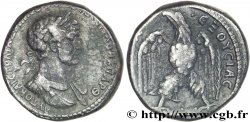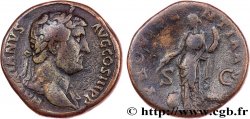E-auction 152-90475 - bpv_153671 - HADRIAN Tétradrachme syro-phénicien
You must signin and be an approved bidder to bid, LOGIN TO BID. Accounts are subject to approval and the approval process takes place within 48 hours. Do not wait until the day a sale closes to register. Clicking on « bid » constitutes acceptance of the terms of use of cgb.fr private e-auctions.
Bids must be placed in whole Euro amounts only. The sale will start closing at the time stated on the item description; any bids received at the site after the closing time will not be executed. Transmission times may vary and bids could be rejected if you wait until the last second. For further information ckeck the E-auctions F.A.Q.
NO BUYER'S FEE.
NO BUYER'S FEE.
| Estimate : | 160 € |
| Price : | 70 € |
| Maximum bid : | 82 € |
| End of the sale : | 14 March 2016 15:14:00 |
| bidders : | 10 bidders |
Type : Tétradrachme syro-phénicien
Date: 118
Mint name / Town : Antioche, Syrie, Séleucie et Piérie
Metal : silver
Diameter : 24,50 mm
Orientation dies : 6 h.
Weight : 14,10 g.
Coments on the condition:
Nette usure de circulation, renforcée par le très haut relief des types
Catalogue references :
Predigree :
Cet exemplaire est le 0156_022, il provient de la trouvaille dite de Banias
Obverse
Obverse description : Buste fin, lauré et cuirassé, d’Hadrien à droite vu de trois-quarts de face.
Obverse legend : AUT KAI QE TRA PAR UI QE NER UI TRAI ADRIANOS SEB.
Obverse translation : (L'empereur césar fils du divin Trajan le Parthique, fils du divin Nerva, Trajan Hadrien auguste).
Reverse
Reverse description : Aigle élancé debout à droite, tête et queue à gauche, sur un cuissot d’animal sacrificiel, les ailes déployées.
Reverse legend : DHMARC EX UPAT . B.
Reverse translation : (Tribun du Peuple, Consul pour la deuxième fois).
Commentary
Première émission d’Antioche sur tous les nouveaux standards récemment établis : légendes à messages politiques, aigle “vivant” en attitude d’envol et non hiératique, cuissot sacrificiel dans les serres, disparition de la palme dans le champ, axe à 6 heures.
Le graveur a changé par rapport à l’émission précédente et cette frappe, comme la suivante du troisième consulat, est la dernière frappe à motivations économiques, donc en quantité importante, avant les frappes des Sévères. Il faut croire que l’afflux de tétradrachmes de Trajan aux types de l’aigle, de la Tyché et du Melqart fut suffisant pour alimenter le marché pendant trois quarts de siècle, aidés en cela par les très importantes frappes de Césarée de Cappadoce.
On note que les sigma sont gravés en C.
Dans la base TSP maintenue par Michel Prieur, quatre-vingt cinq exemplaires sont maintenant répertoriés dont pour les musées ANS, Paris(3), Berne (2), Fitzwilliam Museum Mc Lean Collection et Yale (2).
Le graveur a changé par rapport à l’émission précédente et cette frappe, comme la suivante du troisième consulat, est la dernière frappe à motivations économiques, donc en quantité importante, avant les frappes des Sévères. Il faut croire que l’afflux de tétradrachmes de Trajan aux types de l’aigle, de la Tyché et du Melqart fut suffisant pour alimenter le marché pendant trois quarts de siècle, aidés en cela par les très importantes frappes de Césarée de Cappadoce.
On note que les sigma sont gravés en C.
Dans la base TSP maintenue par Michel Prieur, quatre-vingt cinq exemplaires sont maintenant répertoriés dont pour les musées ANS, Paris(3), Berne (2), Fitzwilliam Museum Mc Lean Collection et Yale (2).








 Report a mistake
Report a mistake Print the page
Print the page Share my selection
Share my selection Ask a question
Ask a question Consign / sell
Consign / sell
 Full data
Full data



